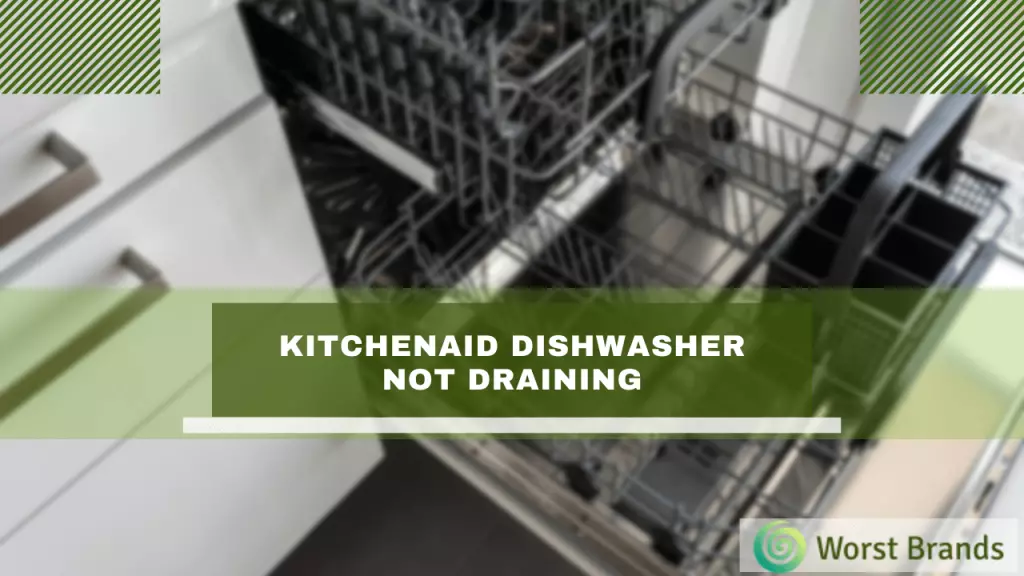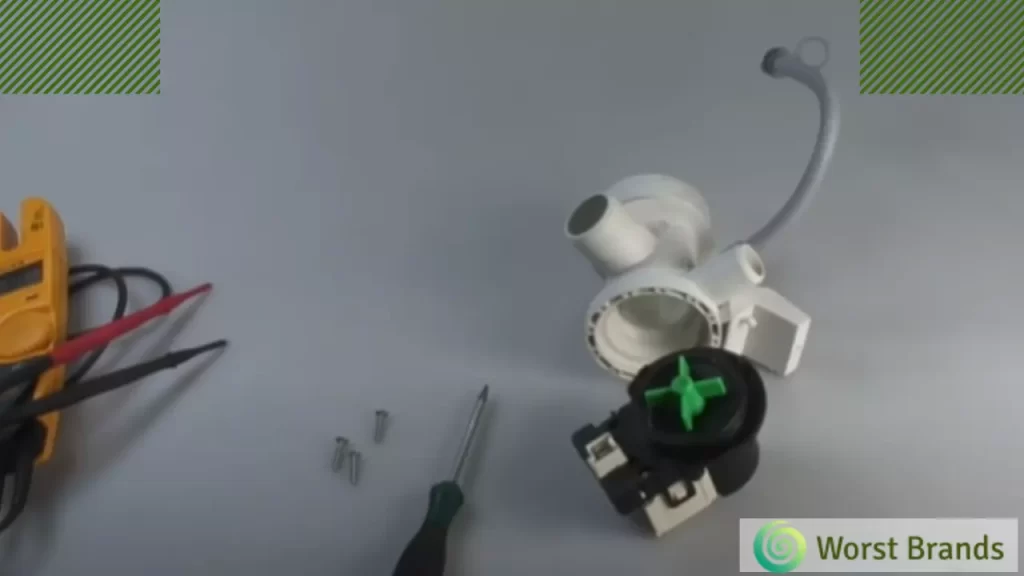It is frustrating when your KitchenAid dishwasher stops draining your dirty dishes or doesn’t drain them at all. You will have to spend extra time scrubbing the dishes by hand, which is time-consuming and tedious.
The most common causes for a KitchenAid dishwasher not draining include a clogged drain valve, issues in the drain pump, and a faulty water inlet valve.
KitchenAid is a high-quality brand that you can find in many homes. However, sometimes their dishwashers won’t drain due to various reasons.
Not all the time, these problems are big, sometimes, a minor repair is required to fix them.
I will cover all of the reasons with simple DIY troubleshooting tips. You should try it by yourself before calling a repair person.

Table of Contents
- KitchenAid Dishwasher Not Draining
- 1. Clogged Drain Valve
- 2. Check the Drain Pump
- 3. Unclog the Main Drain from the Home Plumbing System
- 4. Clogged Garbage Disposal
- 5. Check for Air Gap Behind the Dishwasher
- 6. Replace the water inlet valve
- What are the Best Ways to Prevent a Leaky Dishwasher?
- How to Identify Dishwasher Noise Problems and Other Mechanical Issues
- How Do You Force a Dishwasher to Drain?
- Can You Manually Drain a Dishwasher?
- Conclusion
- Steven Settles
KitchenAid Dishwasher Not Draining
Check out the top 7 reasons why KitchenAid dishwashers won’t drain, along with easy troubleshooting steps to fix them.
1. Clogged Drain Valve
If your KitchenAid dishwasher is not draining and you have a clogged drain valve, there are a few things you can try to fix that should help.
- First, unblock the drain line.
- Clean out the filter and remove any food particles that may be clogging it.
- If you have confirmed that the drain line is blocked, then use a plunger to clear the obstruction.
The most common cause of obstruction in a dishwasher is grease or food particles that are stuck to the valve opening.
Use a needle or long object with some string attached to poke through these items with force for the best results.
You can also manually open and close the valve opening with your fingers to clear out any debris blocking it.
2. Check the Drain Pump

There are many reasons why a dishwasher’s drain pump may not be working properly.
If the water is unable to drain, it will overflow and leave water in the bottom of the dishwasher. This can cause mold to grow inside the machine.
Your dishwasher is equipped with a small, powerful pump that sucks all of the dirty water out of the dishwasher and into your kitchen sink or outside drain.
The pump must work correctly for your dishes to be clean and dry at the end of the wash cycle.
When your KitchenAid dishwasher’s drain pump does not work, then you will not be able to get your dishes clean.
Below are some reasons why your KitchenAid dishwasher’s drain pump may stop working correctly and how you can troubleshoot them:
- Check if there is an obstruction in the hose or pipe
- Replace the inlet filter or degreaser filter
- Check for kinks or crimps in the drain hose
- Check for loose
Apart from draining, a faulty pump or motor can also cause the KitchenAid dishwasher not to start.
3. Unclog the Main Drain from the Home Plumbing System
The main drain is the pipe that connects the house’s wastewater to the sewage system. The pipe runs from under your home to a septic tank, cesspit, or treatment plant.
On average, there are about 15 liters of water in this drain at any time. It is important that you don’t put anything down this drain that will clog it up.
This can include hair, soap slivers, toothpaste, and other things.
Suppose you have a sink with a garbage disposal unit in your kitchen. In that case, there should be another pipe connecting to the septic system (sewer), too (called an ‘ejector pump’).
This second pipe will need to be checked for blockages regularly.
A clogged drain can also result in the KitchenAid dishwasher not drying dishes properly.
4. Clogged Garbage Disposal
When a dishwasher is not draining, the problem could be clogged garbage disposal or a blocked sink drain.
A dishwasher may also not drain if the discharge hose is too low.
Food particles accumulating on the dishwasher’s water intake screen might potentially create a blockage.
If you suspect that your kitchen sink might be clogged, try plunging it with a plunger or pouring boiling water down it to clear any food or debris that might be blocking it.
Inspecting under the sink for leaks and making sure everything is correctly assembled, including pipes and connections, can also eliminate some problems.
5. Check for Air Gap Behind the Dishwasher
An air gap is a space that must be present behind the dishwasher to allow for the drainage of water.
The dishwasher should not be installed too close to the sink. An air gap between the sink and the dishwasher is necessary so that water doesn’t back up and overflow.
Homeowners can also install a tub spout or other device to ensure water drainage from behind the dishwasher.
Checking for an air gap requires homeowners to remove the panel on either side of their dishwasher.
If there is an air gap, there will be a gasket or seal on one side that corresponds with the space on the other side.
If there’s no seal, then there may not be enough room behind your dishwasher for it to drain properly.
Homeowners can add a foot or two of clearance to their dishwashers by installing an extension kit to fix this issue.
6. Replace the water inlet valve
When the KitchenAid dishwasher doesn’t drain properly, usually the water inlet valve is to blame. Replacing this valve is usually a straightforward process.
A dishwasher’s water inlet valve is responsible for supplying cold water to the dishwasher. It also opens and closes according to the needs of the dishwasher.
This means that when you need more cold water, like during a wash cycle, it will open and allow more cold water in.
Once your wash cycle has finished, it will close again so that it doesn’t continue to supply cold water to your dishes.
Suppose you are experiencing issues with your dishwasher not draining properly or notice that it takes longer than usual to wash your dishes. In that case, there might be an issue with your water inlet valve.
These were some of the most common reasons why your KitchenAid dishwasher won’t drain.
What are the Best Ways to Prevent a Leaky Dishwasher?
There are many ways to prevent a leaky dishwasher. However, the more common ones are to clean the filters regularly and to insulate pipes.
Filters are designed to stop food particles from entering the water system, so if they get clogged up with food particles, they will cause problems for your dishwasher.
If you want your machine to run smoothly, you must keep it clean.
Here are the following steps to prevent leakage in dishwashers:
- Check for loose parts, such as the door hinges
- Fill gaps in between the door and dishwasher with a sealant
- Replace any worn gaskets or seals with new ones
- Remove any debris that may be clogging the drain or preventing water flow in the machine
You should also insulate your pipes if they are in an exterior wall or if they have had some work done on them recently.
This will prevent vibrations from passing through the home wall, which could cause leaks in your dishwasher.
If you need help with this, speak with a professional who can provide insulation for these pipes for you!
How to Identify Dishwasher Noise Problems and Other Mechanical Issues
Dishwasher problems can be identified by identifying noise issues and other mechanical issues.
Noise issues: The dishwasher could be making squeaky noise when the dishwasher door is opened. This could be caused by a tight latch or a loose door hinge.
The dishwasher could also make loud noises because of clumps of food caught in the drain pump and filter.
Other mechanical problems: The dishwasher may not be draining water correctly if there is water left in the bottom of the unit or not filled with enough water to cover dishes.
How Do You Force a Dishwasher to Drain?
There are two mechanisms for ensuring that dishwasher water drains.
The first is the float valve. This is a spring that lifts up when the water level gets too high and blocks the sink, forcing it to drain out.
The second is a pump. This pump sucks in air from the pipes through which water is draining and forces it back into the dish, raising its level and making it flow again towards the drain.
The most common cause of difficulty with dishwashers is food or dirt blocking either of these mechanisms. To unblock them, you need to remove whatever has got stuck in there, usually by taking off any removable filters or parts like a dishwasher basket.
If this doesn’t work, open up your machine’s filter compartment on top of your machine and try pushing on the filter with a broom handle to free anything that may have become blocked.
Can You Manually Drain a Dishwasher?
You have to have a clear understanding of the functions of a dishwasher before you can understand how to drain it manually.
You need to know that they come in two types: top-mount and front-load.
Front-loaders usually have a button on the door when you open it that will drain the water from the bottom of the machine.
They also have a water inlet valve at the bottom where all you need to do is pull it out and turn it off.
On top-mount models, there is usually an opening on one of the sides at or near the top of the dishwasher. It will be covered with a removable cap and might be called an “inlet valve.”
You can open this cap, pull out any stray debris that may get caught inside, and then close it.
Check out the following troubleshooting blog if you have drainage issues in other dishwasher brands:
Conclusion
If your KitchenAid dishwasher is not draining properly, the issue may be either with the drain pump, the drain valve, or the drain hose.
Check for any clogs in the drain hose. If you think there is a problem with the drain pump, you can inspect it yourself.
But, if you cannot detect the problem, we recommend not to experiment with your dishwasher. You can consult with the KitchenAid service center to provide you with assistance to resolve your issue.

Steven Settles is an ISCET-certified master in appliance repair. He has aced the National Appliance Service Technician Certification Exam, showcasing his exceptional diagnostic and repair skills. With an in-depth understanding of the latest repair technologies and a keen eye on evolving industry standards, Steven is a go-to expert for any appliance issue.